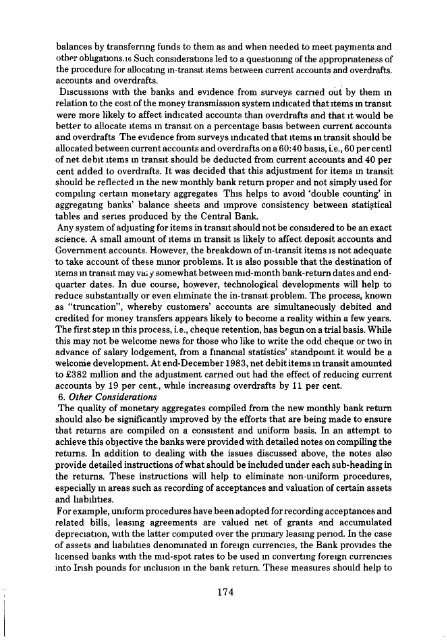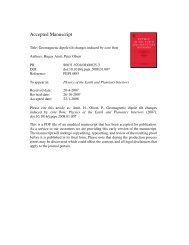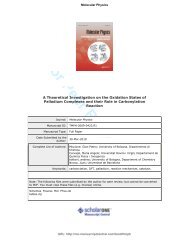parti: objectives and features of the new reporting system 159 - TARA
parti: objectives and features of the new reporting system 159 - TARA
parti: objectives and features of the new reporting system 159 - TARA
Create successful ePaper yourself
Turn your PDF publications into a flip-book with our unique Google optimized e-Paper software.
alances by transferring funds to <strong>the</strong>m as <strong>and</strong> when needed to meet payments <strong>and</strong><br />
o<strong>the</strong>r obligations. 16 Such considerations led to a questioning <strong>of</strong> <strong>the</strong> appropriateness <strong>of</strong><br />
<strong>the</strong> procedure for allocating in-transit items between current accounts <strong>and</strong> overdrafts,<br />
accounts <strong>and</strong> overdrafts.<br />
Discussions with <strong>the</strong> banks <strong>and</strong> evidence from surveys carried out by <strong>the</strong>m m<br />
relation to <strong>the</strong> cost <strong>of</strong> <strong>the</strong> money transmission <strong>system</strong> indicated that items in transit<br />
were more likely to affect indicated accounts than overdrafts <strong>and</strong> that it would be<br />
better to allocate items in transit on a percentage basis between current accounts<br />
<strong>and</strong> overdrafts The evidence from surveys indicated that items in transit should be<br />
allocated between current accounts <strong>and</strong> overdrafts on a 60:40 basis, i.e., 60 per centl<br />
<strong>of</strong> net debit items m transit should be deducted from current accounts <strong>and</strong> 40 per<br />
cent added to overdrafts. It was decided that this adjustment for items in transit<br />
should be reflected in <strong>the</strong> <strong>new</strong> monthly bank return proper <strong>and</strong> not simply used for<br />
compiling certain monetary aggregates This helps to avoid 'double counting' in<br />
aggregating banks' balance sheets <strong>and</strong> improve consistency between statistical<br />
tables <strong>and</strong> series produced by <strong>the</strong> Central Bank.<br />
Any <strong>system</strong> <strong>of</strong> adjusting for items in transit should not be considered to be an exact<br />
science;. A small amount <strong>of</strong> items in transit is likely to affect deposit accounts <strong>and</strong><br />
Government accounts. However, <strong>the</strong> breakdown <strong>of</strong> in-transit items is not adequate<br />
to take account <strong>of</strong> <strong>the</strong>se minor problems. It is also possible that <strong>the</strong> destination <strong>of</strong><br />
items in transit may vaiy somewhat between mid-month bank-return dates <strong>and</strong> endquarter<br />
dates. In due course, however, technological developments will help to<br />
reduce substantially or even eliminate <strong>the</strong> in-transit problem. The process, known<br />
as "truncation", whereby customers' accounts are simultaneously debited <strong>and</strong><br />
credited for money transfers appears likely to become a reality within a few years.<br />
The first step in this process, i.e., cheque retention, has begun on a trial basis. While<br />
this may not be welcome <strong>new</strong>s for those who like to write <strong>the</strong> odd cheque or two in<br />
advance <strong>of</strong> salary lodgement, from a financial statistics' st<strong>and</strong>point it would be a<br />
welcome development. At end-December 1983, net debit items in transit amounted<br />
to £382 million <strong>and</strong> <strong>the</strong> adjustment carried out had <strong>the</strong> effect <strong>of</strong> reducing current<br />
accounts by 19 per cent., while increasing overdrafts by 11 per cent.<br />
6. O<strong>the</strong>r Considerations<br />
The quality <strong>of</strong> monetary aggregates compiled from <strong>the</strong> <strong>new</strong> monthly bank return<br />
should also be significantly improved by <strong>the</strong> efforts that are being made to ensure<br />
that returns are compiled on a consistent <strong>and</strong> uniform basis. In an attempt to<br />
achieve, this objective <strong>the</strong> banks were provided with detailed notes on compiling <strong>the</strong><br />
returns. In addition to dealing with <strong>the</strong> issues discussed above, <strong>the</strong> notes also<br />
provide detailed instructions <strong>of</strong> what should be included under each sub-heading in<br />
<strong>the</strong> returns. These instructions will help to eliminate non-uniform procedures,<br />
especially in areas such as recording <strong>of</strong> acceptances <strong>and</strong> valuation <strong>of</strong> certain assets<br />
<strong>and</strong> liabilities.<br />
For example, uniform procedures have been adopted for recording acceptances <strong>and</strong><br />
related bills, leasing agreements are valued net <strong>of</strong> grants <strong>and</strong> accumulated<br />
depreciation, with <strong>the</strong> latter computed over <strong>the</strong> primary leasing period. In <strong>the</strong> case<br />
<strong>of</strong> assets <strong>and</strong> liabilities denominated in foreign currencies, <strong>the</strong> Bank provides <strong>the</strong><br />
licensed banks with <strong>the</strong> mid-spot rates to be used in converting foreign currencies<br />
into Irish pounds for inclusion in <strong>the</strong> bank return. These measures should help to<br />
174
















